


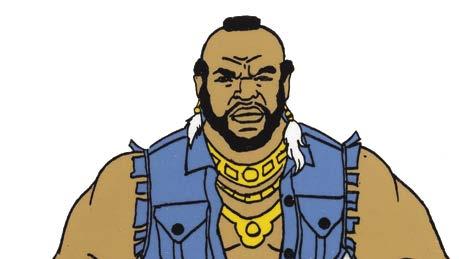

May 2023 No. 26 $10.95 1 8 2 6 5 8 0 0 5 0 4 7 SATURDAY SATURDAYSUPER-HEROESMORNING’S SUPER-HEROESMORNING’S Go cross-eyed over DAKTARI’s lion lover, CHERYL MILLER The actress who was almost Emma Peel, ELIZABETH SHEPHERD Meet EL VAMPIRO and other Monsters, Mexican style! I pity the fool who misses this issue! A MR. T HISTORY Featuring Andy Mangels • Will Murray • Scott Saavedra • Scott Shaw! • Mark Voger • Michael Eury TV’s Avengers, Steed and Mrs. Peel • John and Yoko’s nation of Nutopia & more! Super Friends © DC Comics. Daktari © Warner Archives. Mr. T © Ruby-Spears Productions. All Rights Reserved.
Special

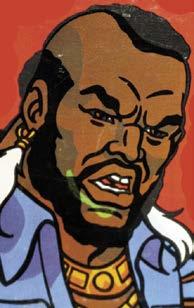



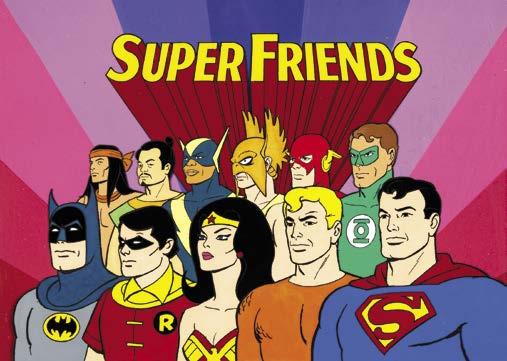


RetroFan™ issue 26, May 2023 (ISSN 2576-7224) is published bi-monthly by TwoMorrows Publishing, 10407 Bedfordtown Drive, Raleigh, NC 27614, USA. Phone: (919) 4490344. Periodicals postage paid at Raleigh, NC. POSTMASTER: Send address changes to RetroFan, c/o TwoMorrows, 10407 Bedfordtown Drive, Raleigh, NC 27614. Michael Eury, Editor-in-Chief. John Morrow, Publisher. Editorial Office: RetroFan, c/o Michael Eury, Editor-in-Chief, 112 Fairmount Way, New Bern, NC 28562. Email: euryman@gmail.com. Six-issue subscriptions: 73 Economy US, $111 International, $29 Digital. Please send subscription orders and funds to TwoMorrows, NOT to the editorial office. Super Friends TM & © DC Comics. Daktari © Warner Bros. Mr. T © Ruby-Spears Productions. All Rights Reserved. All characters are © their respective companies. All material © their creators unless otherwise noted. All editorial matter © 2023 Michael Eury and TwoMorrows. Printed in China. FIRST PRINTING. Departments
3 Andy Mangels’ Retro Saturday Morning Super Friends 19 Scott Saavedra’s Secret Sanctum John and Yoko’s Nation of Nutopia 25 Will Murray’s 20th Century Panopticon Steed and Mrs. Peel: TV’s The Avengers 36 Retro Interview Elizabeth Shepherd, ‘The Emma Peel That Almost Was’ 41 Voger’s Vault of Vintage Varieties Mexican Monsters 53 Retro Television Daktari ’s Cheryl Miller 61 Oddball World of Scott Shaw! Mr. T 2 Retrotorial 16 Too Much TV Quiz TV character occupations 48 Retro Collectibles All in the Family Merchandise 75 RetroFad Bra burning 76 Retro Travel Cleveland, Ohio, hometown of Superman’s creators 78 RetroFanmail 80 ReJECTED The Crazy Cool Culture We Grew Up With 19 53 3 25 61 48 41
Features
PART 1BY ANDY MANGELS
“In the great hall of the Justice League there are assembled the world’s four greatest heroes,created from the cosmic legends of the universe: Superman, Wonder Woman, Batman, Aquaman… and those three junior Super Friends, Wendy, Marvin, and Wonder Dog. Their mission: To fight injustice; to right that which is wrong; and to serve all mankind!”
This narration for the opening of 1973’s Super Friends —Ted Knight’s announcing paired with Hoyt Curtain’s percussive opening music—would drive fans to Saturday mornings on ABC for 13 years to follow, through nine different incarnations and as many titles. Over the next four issues of RetroFan, Andy Mangels’ Retro Saturday Morning will be your guide to the longest-running animated superhero series ever!

SATURDAY MORNING VIOLENCE BECOMES FRIENDLY
DC Comics’ super-heroes had been well represented since the dawn of Saturday morning television, with Filmation’s The New Adventures of Superman on CBS from September 1966–September 1967 [see RetroFan #25, available to order in print or digital at www. twomorrows.com —ed.], followed by The Superman/Aquaman Hour of Adventure and its Justice League and guest hero shorts on CBS from September 1967–September 1968 [see RetroFan #3], and The Batman/ Superman Hour on CBS, from September 1968–September 1969. But as the Seventies dawned, so-called “moral watchdogs” like Action for Children’s Television (ACT) were making their voices heard, and critical editorials were written in newspapers and magazines, debating about “violence” on Saturday morning shows, specifically
RETROFAN May 2023 3 ANDY MANGELS’ RETRO SATURDAY MORNING
TM & © DC Comics.
for super-hero shows (which generally showed less violence than a Disney film). The entertainment industry newspapers reported that for the 1969–1970 seasons, both ABC and CBS were making pacts to eliminate violent programming—and that comedy would rule the airwaves. Indeed, by Fall 1970, all traces of super-heroes had been wiped from Saturday morning schedules.
Even hamstrung by ACT’s agenda, Filmation used Superman and Batman on Children’s Television Workshop’s Sesame Street educational segments, then featured Superman and the television debut of Wonder Woman on ABC’s The Brady Kids, in Fall 1972. Batman and Robin, meanwhile, were licensed to Hanna-Barbera to appear in a pair of CBS New Scooby-Doo Movies. Fred Silverman, who had championed heroes at CBS, was now in charge at ABC. He wondered: could they bring back DC super-heroes in a friendlier non-violent way? The alphabet network commissioned HannaBarbera to create the new series, specifying that the stories had to be moralistic and nonviolent.
Hanna-Barbera chose five of DC Comics’ top heroes to headline the series: Superman, Wonder Woman, Aquaman, Batman,
and Robin… although the teen hero was so ill-respected that he didn’t even rate getting named in the show opening. Meanwhile, Aquaman was considered more popular than Flash or Green Lantern since he had already starred in his own animated series, so even though the writers were saddled with adding water-based elements to every storyline, the Aquatic Ace was in. Joining the team—alternately called the “Justice League” or the “Super Friends,” were teen sidekicks Wendy, Marvin, and Wonder Dog. The latter two of these “junior Super Friends” would occasionally exhibit super-powers if the story demanded it; Wendy had no powers, but was often the smartest character in the room.
Comic master artist Alex Toth had previously designed such characters as Space Ghost and Birdman for Hanna-Barbera, so from March through July 1973, he was brought in to give all the characters a dynamic flair, simplistic enough for animation, but respectful of their comic-book roots. In one of Wonder Woman’s model sheets, Toth designed her to look more like her Golden Age version, but she reverted to a modern interpretation in later designs. The artist also changed Superman’s look when DC Comics

ANDY MANGELS ’ RETRO SATURDAY MORNING RETROFAN May 2023 4
A Golden Age-inspired version of Wonder Woman by Alex Toth. It was ultimately unused. TM & © DC Comics.
roles for Super Friends. Kasem had come from college radio shows prior to becoming a voice actor; ironically, he became one of the most famous radio deejays in the world. He was also the voice of Shaggy on Hanna-Barbera’s various Scooby-Doo series, where he worked with Frank Welker as Scooby instead of as Wonder Dog. Alberoni was another H-B alumni; the former Mickey Mouse Club mouseketeer had been a lead voice on Josie and the Pussycats
Alden, who voiced Aquaman with a stoic clearness, was a character actor who was probably most recognizable to later Saturday morning viewers as Professor Frank Heflin on Sid and Marty Krofft’s Electra Woman and DynaGirl series in 1976 [see RetroFan #8], and to later audiences for his role as the soda jerk in Back to the Future (1985) and sad sack cameraman in Ed Wood (1994). In a 2007 interview with Alden on the website Aquaman Shrine, the actor recalled that he got the Hanna-Barbera job due to a friend he had once loaned a car to. “I didn’t know [Aquaman] was going to be a treasure,” he admitted. “It’s a phenomenon. I go around, I’m just sitting in a restaurant or something, and somebody will come by and say ‘You’re Aquaman!’”
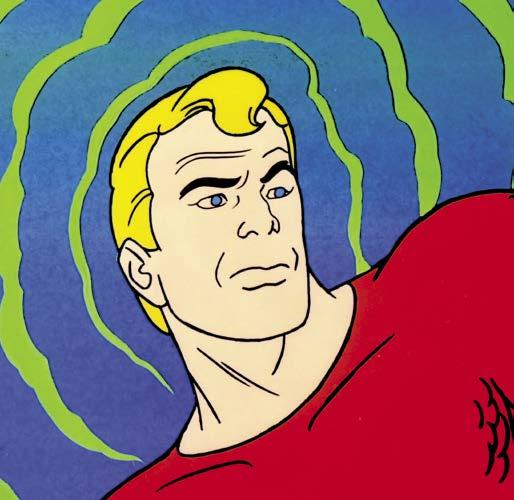
Of the 16 episodes produced, adventures included guest-stars Green Arrow, Flash, and a brief cameo for Plastic Man, and saw the Super Friends battle a super-computer called G.E.E.C., dastardly polluters, and alien balloon people. Unlike almost every regular half-hour series on Saturday morning, the Super Friends episodes also

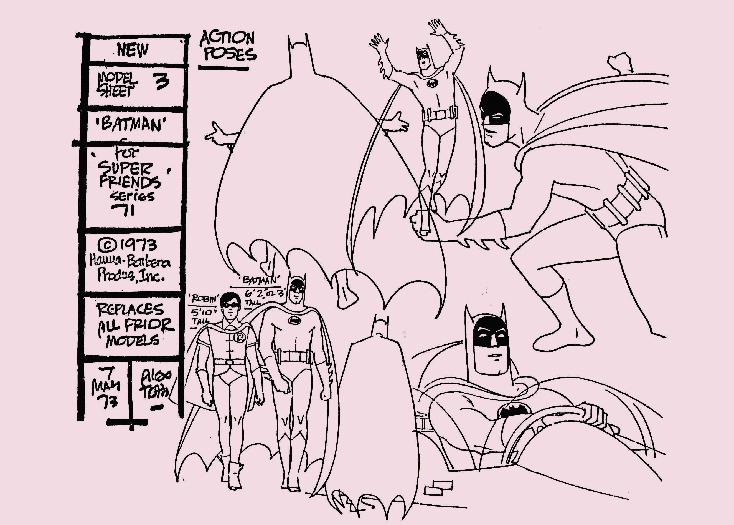

ANDY MANGELS ’ RETRO SATURDAY MORNING
RETROFAN May 2023 8
(LEFT) Aquaman calls to the beasts of the sea in this screen capture from the first season of Super Friends. (RIGHT) Aquaman head turn reference. TM & © DC Comics.
(TOP) Batman and Robin action poses by Alex Toth. (ABOVE) The Batmobile in action in this screen capture from Super Friends TM & © DC Comics.
(TOP) Green Arrow model sheet for a Super Friends featured guest-star. The show features a handful of characters from DC’s stable of super-heroes. (CENTER) Revised model sheet for Wonder Woman. (BOTTOM) A model sheet for another guest-star, Plastic Man. Alex Toth clearly has fondness for the character who first appeared in comic books in 1941. Here he refers to the hero as “The one and only original.” TM & © DC Comics.
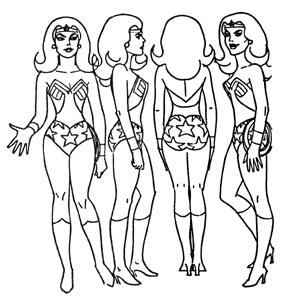
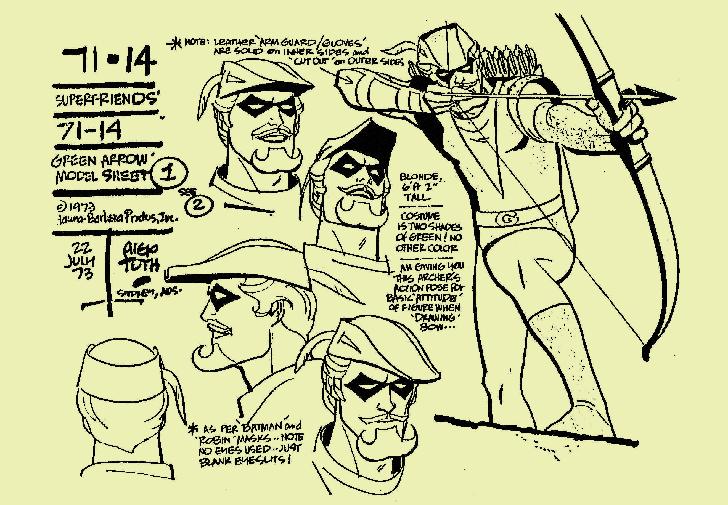

featured an hour-long story—albeit a heavily padded tale.
Super Friends creative producer Iwao Takamoto would recall in his own biography, My Life with a Thousand Characters, that “Viewers loved this show. It was one of the top-rated programs on Saturday morning. And the writers and the story editors at Hanna-Barbera loved doing the show… The only people who did not like the show were the editors of DC Comics, who actually did take this stuff seriously. To say ‘disliked’ is actually an understatement: they wanted our heads. I never got so many irate letters about anything as those that came from the comic-book staff regarding how we were handling the characters. There was a high degree of sarcasm to them, an underlying viciousness that sometimes go to the point of being X-rated… Periodically I would gather these vindictive missives up and take them into the show writers and show them to them. The reply I usually got from them was no less blunt than the letters: ‘Ah, tell them to go f*** themselves!’”
By accounts, the prime offended party at DC Comics was editor and writer E. Nelson Bridwell, who was generally in charge of keeping DC continuity as cohesive as possible… and who functioned as DC’s “Story Advisor” for Hanna-Barbera. He stopped Hanna-Barbera from making Bruce Wayne the uncle of Wendy (reportedly, she called him “Uncle Bruce” in early scripts), but he couldn’t get the animators to make the Justice League satellite the headquarters for the group; instead, Hanna-Barbera used the Hall of Justice, a building in an unnamed city that was based on the visual look of Cincinnati’s art deco-designed Union Terminal. Inside the Hall, the cavernous meeting room held not only tons of colorful computers and a meeting table, but also the wall-mounted giant-screen TroubAlert (later called “Trouble Alert”) on which government liaison Colonel Wilcox would warn the Super Friends of some impending disaster.
In late 1975, Bridwell wrote comics’ first Super Friends story for the treasury-sized Limited Collector’s Edition #C-41, with art by Alex Toth. Shortly thereafter, Bridwell launched an ongoing Super Friends series, in which DC’s continuity cop attempted to reconcile the animated adventures with the larger DC universe, even linking Wendy properly to Batman (she was instead the
ANDY MANGELS ’ RETRO SATURDAY MORNING RETROFAN May 2023 9
John and Yoko’s Nation of Nutopia
BY SCOTT SAAVEDRA
I am a citizen of Nutopia, and if you aren’t already one yourself you could be soon. But don’t expect to vacation there anytime ever, because Nutopia is a state of mind rather than an actual state.

Simply, Nutopia is a conceptual country. And it was founded by Yoko Ono and John Lennon in 1973 on the first day of April (no foolin’) when the following statement was signed:
We announce the birth of a conceptual country, NUTOPIA. Citizenship of the country can be obtained by declaration of your awareness of NUTOPIA.
NUTOPIA has no land, no boundaries, no passports, only people.
NUTOPIA has no laws other than cosmic.
All people of NUTOPIA are ambassadors of the country. As two ambassadors of NUTOPIA, we ask for diplomatic immunity and recognition in the United Nations of our country and its people.
[Signed by]
Yoko Ono Lennon
John Ono Lennon
The very next day, Lennon and Ono held a press conference at the Association of the Bar of the City of New York to announce the founding of Nutopia. John Lennon’s voice was strong and clear as he read the letter but Yoko Ono, who read along, was barely audible despite sitting in front of a microphone. Lennon wore a “Not Insane” button representing the “National Surrealist People’s Party” (never heard of it). Their demeanor appeared rather sober, though deadpan might be a better description. The couple also introduced the flag of Nutopia, which appeared to be simple white handkerchiefs. Asked by a reporter what the
(ABOVE) John Lennon (LEFT) and Yoko Ono (RIGHT) at the 1973 press confrence announcing the creation of Nutopia. Bernard Gotfryd photograph collection/ Library of Congress Prints and Photographs Division. (INSET) The seal of Nutopia (get it?) as drawn by John Lennon.

RETROFAN May 2023 19
SCOTT SAAVEDRA’S SECRET SANCTUM
white flag meant, they each waved one around above their heads: “surrender and submission.” Lennon then used the tissue in a more traditional fashion and blew his nose. Ono would later point out that the full meaning of the flag was to surrender and submit to “peace and love.”
Nutopia appeared to be utterly nonsensical. After all, what’s Cosmic Law? In space, no one can hear you scream? Thou shalt not covet your neighbor’s heavenly body? (I could do this all day.) What on Earth did it all mean? Well, they were artists and artists do unexpected things. At least that’s how Ono explained the abrupt creation of Nutopia to their lawyer Leon Wildes after the press conference. Wildes was unfazed, even though he had serious work to do for the couple. Lennon and Ono were in the midst of a difficult personal time. Ono’s daughter had been abducted by her ex-husband, and ex-Beatle Lennon was on the verge of being deported from the U.S. That escalated quickly, didn’t it?
ALL WE ARE SAYING
John Lennon and Yoko Ono were married in 1969, following divorces from their previous spouses, in Gibraltar. The ten-minute cere-
mony was held at the local registry office, where they managed to avoid the explosion of press and paparazzi they could expect at a more accessible venue in the U.K. But they knew there would be strong interest once their marriage was announced. Wanting to take advantage of the press attention, they spent their honeymoon at the Amsterdam Hilton, Netherlands, where they held a weeklong “Bed-in for Peace.”
As expected, the press showed up enthusiastically. Not expected were the journalists who thought the couple might have marital relations (wink) in front of the press while they covered the Bed-in. This did not happen, as Lennon would say he and Ono were both “angels” the entire time. He wore pajamas and Ono wore a nightgown. It was all very Ozzie and Harriet, with a counterculture spin. In keeping, more or less, with the theme that love leads to peace Ono did say at the Bed-in that she could have reformed noted historical monster Adolf Hitler (oh, no) in only ten days (stop) as his girlfriend (please stop) with some non-marital relations (ick). This comment didn’t land well in the expected places (nearly everywhere), but like Lennon’s previous comment about The Beatles being “bigger than Jesus,” it did blow over.
A follow-up Bed-in was intended for the U.S., but Lennon’s request was turned down. So the couple headed to Montreal (after a night too hot for Bed-ins in the Bahamas). For this Bed-in they were joined by famous guests including Tommy Smothers, Dick Gregory, Petula Clark, Timothy Leary, and a crabby, hippie-hating Al Capp (who at least managed to keep his “L’il Abner” in his pants). You didn’t have to be famous to come to the Bed-in. Everyone was invited to come to the hotel, although access to the room was limited. And people came. Why, the Breckville Recorder & Times of Ontario reported that roughly “200 hippies” showed up!

(ABOVE) Souvenir stamp sheet from Gibraltar commemorating the 30th anniversary of the wedding of Lennon and Ono. The actual stamp leaves out Ono (there’s a metaphor in there somewhere). (RIGHT)

Ono and Lennon at their first Bed-in at the Amsterdam Hilton in 1969 following their wedding. © National Archives, Netherlands. Photographer Eric Koch/ Anefo. Wikimedia. (INSET) The second Bed-in in Montreal had some well-known guests including radio disk jockey Murray the K. Some 200 hippies also showed up. Courtesy of Heritage.
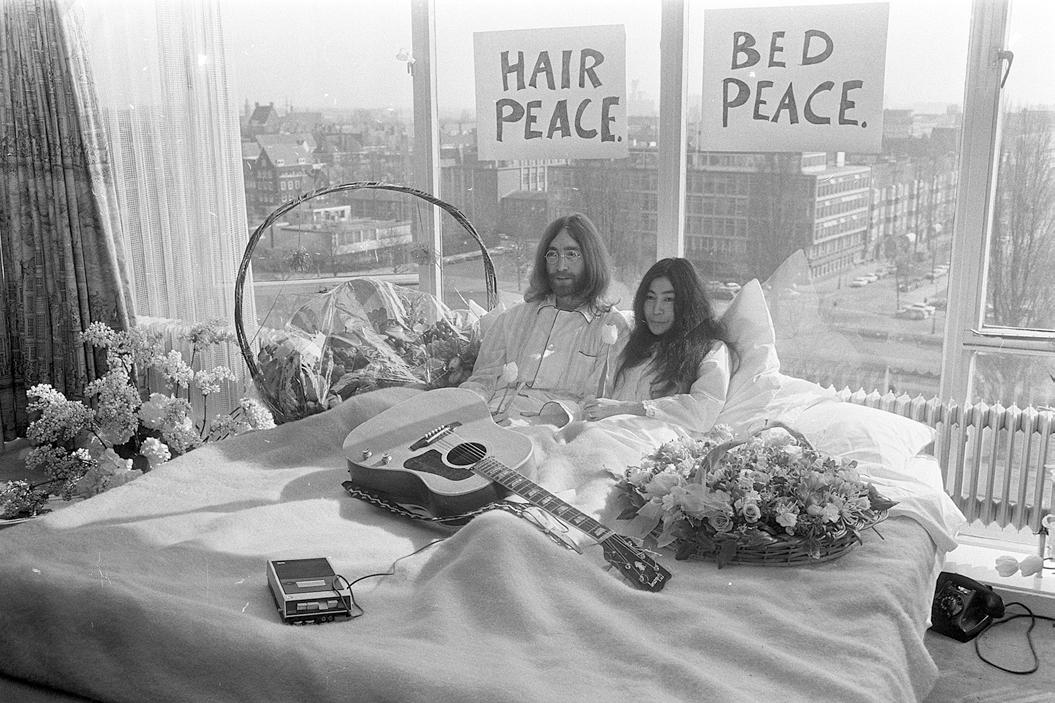
RETROFAN May 2023 20
SCOTT SAAVEDRA’ S SECRET SANCTUM
Cool Britannica Television’s The Avengers
complex than Patrick Macnee playing rakish government agent John Steed with Diana Rigg as his saucy sidekick, Emma Peel.
 BY WILL MURRAY
BY WILL MURRAY
The British invasion of the Sixties is remembered as a time when America was inundated by English music, beginning with The Beatles in 1963. Those shaggy-haired imports re-energized rock ’n’ roll, paving the way for a cultural revolution that reverberates to this day.
But that creative and cultural invasion was not limited to popular music. British television programs started popping up on the three American networks.
The James Bond craze was responsible. The earliest British shows were espionage-oriented: Danger Man, a.k.a. Secret Agent. Similar fare such as The Saint, The Champions, and others followed. [Editor’s note: See RetroFan #6 for James Bond and #14 for The Saint and come back in four months for RetroFan #28’s spotlight on the British Invasion and Beatlemania.] But one rose above all others: The Avengers. In the summer of 1967, ABC offered the series in the U.S.
JOHN STEED

The Avengers was a far different viewing experience for American audiences than it was for British television viewers. In America, the show exploded fully developed. But its roots were much more
The Avengers started in 1961 as a retooling of an Ian Hendry vehicle called Police Surgeon The actor was recast as another medical man, this time named David H. Keel. Patrick Macnee was introduced as a shadowy intelligence agent with whom Keel crosses paths when his fiancée is murdered in the inaugural episode, “Hot Snow.”
“The role will be a kind of extended version of the police surgeon,” explained Hendry, “because Keel will be more directly involved with fighting crime. And as he tangles with villains himself, he’ll have more of the action.”
John Steed was originally conceived as a George Sanders type. Producer Sidney Newman
For he’s a brolly good fellow… Patrick Macnee as The Avengers ’ John Steed in an autographed publicity photo. Also shown is Steed’s actual bowler from the series, which sold for $12,000 in an auction on December 21, 2013. Both, courtesy of Heritage.

RETROFAN May 2023 25
Steed and Peel, The Avengers © Studiocanal S.A.
WILL MURRAY’S 20TH CENTURY PANOPTICON
wanted Macnee to grow a mustache, but the actor refused. Macnee wasn’t even sure he wanted the part. He had just produced a TV documentary series based on Sir Winston Churchill’s memoirs, and envisioned his future to be behind the cameras. But the money proved irresistible.
After the pair finally vanquished drug lord Ronnie Vance in the second episode, “Brought to Book,” they agree to team up to battle injustice on an ongoing basis. Dr. Keel and John Steed were self-appointed Avengers. They operated undercover, without police cooperation, and even though Steed was affiliated with the British government, he appeared to be largely operating on his own. Keel maintained his private practice and the only other recurring character was his nurse-receptionist, Carol Wilson, played by Ingrid Hafner. The series focused on Keel, with Macnee as a frequent but not strictly weekly accomplice. No question as to which was the star and whom the costar.
The series was videotaped, so it was studio-bound and rather talky. Only three episodes and part of the premiere survive today. To modern American eyes, they are slow and stagy teleplays. But British audiences in the early Sixties loved the quirky show. Once The Avengers found its footing, it took off.

Macnee credited Hendry with its early success. “Ian Hendry was such a volatile character,” he asserted, “and he put a great deal more into the series than was really there. We had this great feeling of alertness and it came in from Ian’s mind.”
“Keel is a most attractive character,” explained Hendry. “He combines toughness with compassion, and serves as the conscience of the team.”
The early John Steed was not quite the stylish character he later became. He was manipulative, vaguely brutish, and not the Edwardian-era figure so fondly remembered now.
“The character of John Steed was created purely as a name, as an opposite type to the rather steady doctor,” Macnee explained. “At first you never quite knew if he was good and evil or good. He was a shadowy sort of character who emerged through windows with a pistol and impeccable brolly [umbrella].”

In the early episodes, Steed claimed to be working for the British Secret Service, but was vague about his official affiliations. As the series progressed, his background became even more opaque as Macnee developed his persona, all but eclipsing Dr. Keel’s dour personality.

The transformation was Macnee’s invention. Sidney Newman took him aside and said that he needed to up his game. “Patrick, I’m afraid you’re just not working out. You don’t seem to be anything. Go away and think of something.”
Macnee gave that warning serious thought and adopted the Edwardian clothes, bowler hat, and umbrella, which became the character’s trademarks. The latter two he used as weapons, the bowler being lined with steel while the brolly doubled as a swordstick. Steed usually eschewed firearms.
“I’m not going to carry a gun,” Macnee reportedly said, “I’m going to carry my brain.”
John Steed was more than his clothes and accessories. “I went back to the obvious and made him a combination of Leslie Howard’s Sir Percy Blakeney in The Scarlet Pimpernel, my father, my commanding officer in the Navy who was a dandy and a very brave man, and a character Sir Ralph Richardson played in a film called Q Planes.”
RETROFAN May 2023 26
W ILL M URRAY ’ S 20 TH C ENTURY PANOPTICON
The other Avengers: (TOP) Macnee as Steed and Ian Hendry as Dr. David Keel. (CENTER) John Rollason as Dr. Martin King, with Macnee. (BOTTOM) Julie Stevens as Venus Smith is entranced by Steed’s delight. © Studiocanal S.A.
“I wanted to be Lady Peel,” she quipped, “not really for grandiose reasons, but simply because it seemed to get some rather good comments over on the English aristocracy. Of course they wouldn’t do it.”
Once more, Macnee was delighted. “If I had to sum up my partnership with Diana, I’d say it was not too similar to being bewitched by an impish kid sister.”
Producers promised a more comedic and outrageous take on the series, and they delivered. This was the season in which the Cybernauts were introduced and included episodes such as “Man-eater of Surrey Green” and the infamous “A Touch of Brimstone,” in which Emma Peel was decked out like a dominatrix.
British viewers were initially skeptical, but soon took to the newest Avengers girl. Diana Rigg became the latest international sex symbol.
“I never think of myself as sexy,” Rigg countered. “I identify with the new woman in our society who is evolving. Emma is totally equal to John Steed. The fighting is the most obvious quality. I always win my fights, and personally, I enjoy it—the idea of taking on six men when you know you’re going to win.”
Her personal relationship with Steed danced on the edge of an ambiguity.
“We’re not married and we don’t actually live together because audiences would be bored watching such an obvious relationship, don’t you think?” Rigg observed. “If a scene takes place in the morning, Patrick may be having coffee with me at my place or vice versa. So everything is understood without too much comment.”
“We also play scenes which illustrate that we have keys to each other’s flats,” added Macnee. “Very cozy.”
Elsewhere, Rigg contradicted that impression, noting, “My physical relations with him are, to put it mildly, ambiguous. They’re certainly not active on the screen but I don’t think they did have an affair. I think it was one of those relationships where the promise that they might be in the future sustained it.”
Macnee had a different take. “I should say they slept together at least three or four times a week. The adrenaline of excitement
Nobody does it better (with apologies to Carly Simon): The Avengers had stellar casts in each of its permutations, but the team of Patrick Macnee as Steed and Diana Rigg as Mrs. Peel, seen in this DVD release promotional art, is the best remembered. © Studiocanal S.A.

always leads to sex. What would be very worrying is if we hadn’t gone to bed. Can you imagine Emma Peel in a leather suit and Steed not going to bed with her? I just didn’t make a song and dance about it.”
Producer Julian Wintle insisted, “They are not sleeping together.”
Regarding replacing Honor Blackman, once Rigg had settled into her new role, she quipped, “She’s a marvelous-looking lady but I’ve succeeded in—as they say in Shakespeare—laying the ghost.”
If anything, The Avengers grew even more popular in the U.K. and Europe. The Bond craze will still peaking and American networks took an interest in bringing the series to the U.S.
Sounding like her predecessor, Diana Rigg greeted the news with a softball warning shot. “I’ve only signed for one year. But I suppose with this American deal I’ll have to stay longer. I hadn’t counted on being tied down to one role for such a length of time.”

When she learned that she was receiving less money than the cameraman, Rigg threatened to quit. Out of loyalty to Macnee, she stayed—once she received her raise.
The first Rigg series pitted the duo against larger-than-life villains and James Bond–style world-threatening plots. Many episodes, such as “The Cybernauts,” veered into Spy-Fi territory. Viewers responded positively to these and when the next series was being prepped, the producers decided to go all out.
W ILL M URRAY ’ S 20 TH C ENTURY PANOPTICON RETROFAN May 2023 30
Four unrestored color transparencies from 1966 publicity photos of Diana Rigg as Mrs. Emma Peel. Courtesy of Heritage. The Avengers © Studiocanal S.A.
Mrs. Blade, We’re Needed!
Mrs. Blade, We’re Needed!
The Emma Peel That Almost Was
BY ANTHONY TAYLOR
As The Avengers moved into its fourth season with an eye toward expanding into the American television market via a sale to the American Broadcasting Company (ABC), England’s ITV and A.B.C. (the Associated British Company) felt that producers with a fresh vision were needed. Brian Clemens had been a writer for the series since its earliest days, and now officially became Associate Producer, with Julian Wintle taking the lead spot. With Honor Blackman on her way to menace and romance James Bond as Pussy Galore in Goldfinger, the team’s first order of business was to find a new companion for John Steed.
The replacement for Blackman’s Cathy Gale would be named Emma Peel, and would be portrayed by Elizabeth Shepherd, an actor most known at the time for her role as Ligeia/Rowena in Roger Corman’s The Tomb of Ligeia (1964), in which she co-starred with Vincent Price. After shooting an episode and a half with Patrick Macnee (Steed), Shepherd was let go from the series under mysterious circumstances and replaced by Diana Rigg, who re-shot the scenes already filmed. Many stories about what really happened to cause the replacement have been bandied about over the years, but the truth is less complicated than the myth. I was able to speak with Elizabeth Shepherd and finally get to the bottom of the story.

According to Shepherd’s diary, filming for Ligeia ended July 31st, 1964, and she met Julian Wintle at Elstree Studios to talk about The Avengers on September 14th.
“I do not know if he had approached my manager Peter Eade about me, or whether Peter submitted me. I was aware of the series though not a devotee,” the actress recalled. “Quite honestly, in those early days of TV, theater was what I and most actors took
seriously; we were even a little dismissive of TV as a useful sideline.” The pair met again for dinner on Sunday, September 27th, and Shepherd was offered the role.
“I had no audition or call back—I never did have a film test with Macnee. Julian Wintle was quoted as admiring my ‘terrific personality and good looks—all the ingredients for the series.’ I was simply cast—offered the job—and my manager Peter Eade negotiated the contract. I went to Wig Creations, and we talked costume. I believe I was cast because I was already a frequent star on TV and I was a blonde like Honor Blackman’s Cathy Gale—and ten years younger.” She vividly remembers what Wintle said when he cast her, “Elizabeth, we are going to record the program on film, not tape, so it is going to be ten times better than it was before, and we welcome your own ideas…” She took these words very seriously, but says they eventually became fatal.
Already booked to go on holiday to Venice and Naples, Shepherd was there when the casting was announced to the press. Photos of her in a red leather pantsuit and long coat from her own wardrobe taken in Italy appeared back home in the Daily Mail on October 20th, 1964. She was now officially an Avenger.
After her holiday, Shepherd began shooting her first episode, “The Town of No Return,” directed by Roy Ward Baker. She came to the set with Wintle’s words still fresh in her mind.
According to Shepherd, “In my excitement to make my own mark on the role, I inundated them with ideas! I thought that Emma Peel should be a more equal partner and maybe even initiate some of the action. I had been told Emma Peel was to be warmer and wittier than Cathy Gale, but when I saw the script I saw I needed warmer and wittier dialogue—so came in with my own
RETRO INTERVIEW RETROFAN May 2023 36
Elizabeth Shepherd, in a 1964 promotional shot for The Avengers. The Avengers © Studiocanal S.A.
Double-sided view of one of Shepherd’s “First Emma Peel” autograph cards. The Avengers © Studiocanal S.A. (BACKGROUND) Headlines tell the tale from beginning to end.

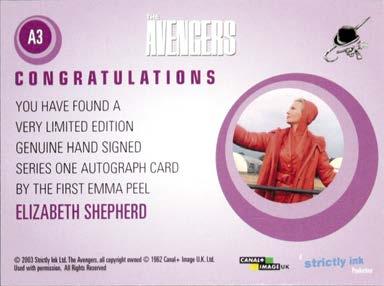
suggestions! That was the start of it… it did not go down well with the writers’ department. Next I was in conflict with the costume department—‘Why not red leather instead of black leather?,’ etc.—‘Oh, no, no, no, must not tread on their territory.’ I thought she could be ultra modern, ahead of her time—with a computer wardrobe maybe, where I could dial in the assignment and the right costume would be forthcoming… much too much even to imagine, let alone put into practice! If not that, maybe a large computer watch which I could consult during assignments, sort of like a diver’s watch, sexy on a delicate wrist.”
The next day, on-set producer Albert Fennell brought her just such a watch to wear.

“I was thrilled!! At the end of the day he came to take it away, saying firmly, ‘We only got it so you could see how foolish it looked…’ I was crushed by such condescension. I could have anticipated Apple and set the trend right there and then!”
At this point, Elizabeth began to doubt that the producers had any intention of listening to her thoughts about the character, and that “Emma Peel”—a name they reached from the idea that the character needed to have “Man Appeal”—was only there to titillate the male audience, and would have no qualities or characteristics that might go against that mandate. Shepherd’s own preference for the character’s name had been Jacqueline Blade, who would have been known as Jack Knife. Clearly, Wintle and Clemens would never go for anything so feminist forward.
One of her experiences on the show did seem at first more promising.
“I did have fun working with (stunt coordinator and future director) Ray Austin on the martial arts—just judo they had
37
Elizabeth Shepherd in 2020.
RETROFAN May 2023
Monsters Mexico
Vampires, mummies, and other fantasmas from south of the border
 BY MARK VOGER
BY MARK VOGER
Being a monster movie fan in the olden days made you a connoisseur of world cinema, whether you realized it or not. You didn’t yet know Federico Fellini, but you knew Atom Age Vampire. You didn’t know Jean Renoir, but you knew The Horror Chamber of Dr. Faustus. You didn’t know Akira Kurosawa, but you knew Ghidorah the Three-Headed Monster
When you were really little, and a dubbed-into-English monster movie came on TV, you may not have even realized it was a “foreign” film. But deep down, you knew it was a little bit off. The lingo, music, production values, and even the film stock were a long way from Universal Pictures’ sparkly canon. And when characters spoke, their mouths didn’t exactly match up with their words. Hmmm…
I fell madly in love with Mexican horror movies from the Fifties and Sixties—black-and-white wonders with cool monsters, chilling music, garishly styled sets, curvy heroines, and the sublime weirdness that lost-in-translation moments alone provide.
Most horror aficionados have heard of the biggies: The Vampire, The Vampire’s Coffin, The Robot vs. the Aztec Mummy, The Brainiac, and the El Santo movies (in which the beloved masked wrestler often battled monsters). But many such films never made it to this side of the Trump Wall. Stateside, they are only obtainable in Spanish
without English subtitles. Still, even if we Yanks can’t grasp the finer points of a given storyline, we can follow these movies. Mexi-horrors communicate in an international language well known to monster-movie geeks.
Mexico’s películas de monstruos often paid homage to American monster movies, especially the Universal classics, but with a moody, amped-up style all their own. In particular, the Mexicans took their vampirism to new heights. If Dracula’s castle was cobwebby the night Renfield arrived, the cobwebs in Mexican vampire movies were as thick and plentiful as cotton candy at a carnival. The fangs were longer, almost tusk-like. The higher, wider cape collars would have delighted James Brown. Dracula had three brides and a slave; Count Subotai in The World of the Vampires (1961) had dozens of tan, rounded, negligee-clad, highhaired brides and an army of fuzz-faced batmen. Did Dracula ever entertain his minions? Count Subotai made like Liberace, playing a gigantic pipe organ festooned with skulls. This was some serious vampirism.
Another mind-blowing thing about Mexi-monster movies: Emulating Universal, Mexican filmmakers created a “society” of monsters that recurred in sequels, and intermingled in subsequent films. Discovering Mexican monster movies was like reading only DC Comics all your life, and then suddenly discovering Marvel. It’s a whole ’nuther universe, bruh!
RETROFAN May 2023 41
VOGER’S VAULT OF VINTAGE VARIETIES
Collage by Mark Voger.
Harbingers of the Mexican horror genre include Fernando de Fuentes’ El Fantasma del Convento (1934), Chano Urueta’s El Monstruo Resucitado (1953), and Urueta’s La Bruja (1954), which starred Lilia del Valle as a disfigured woman—her face is Outer Limits worthy— made beautiful via a scientist’s formula. (The compelling La Bruja, which sometimes brings to mind William Dieterle’s 1939 Hunchback of Notre Dame, is as much drama as horror.) But Mexico’s monster movies, which were often shot at the fabled studio Churubusco Azteca (est. 1945), finally came into their own thanks to a film with a title that is unambiguous in any language: El Vampiro.
Some program notes before we dive in. If a given film was released in the United States (often dubbed by American producer-distributor K. Gordon Murray), I use the English title; otherwise, I use the Spanish title. The spelling of some actors’ names, and the year of release for some films, are occasionally inconsistent (likely a symptom of translation). When this occurs, I go with what seems to be the consensus. I am concentrating on the Fifties–Sixties period, which I consider to be a hallmark, but Mexican horror soldiered on through the Seventies and well beyond, often with—it should come as no surprise—gore and nudity. So please consider what follows a primer, not a comprehensive study. In the wild and wonderful world of Mexican horror films, you never know what obscure gem might pop up next. It’s like friggin’ Whack-a-Mole (in a good way).
MUCHOS VAMPIROS
It’s confusing, looking back, that two movies titled The Vampire came out in 1957: one from America, one from Mexico. In the U.S., where we’d turned our backs on Gothic monsters, The Vampire was about a small-town doctor who takes pills derived from living bats and periodically turns into a monster, Hulk style. In Mexico, where the Universal classics never went out of style, El
(LEFT) The thoughtful La Bruja (1954) was a precursor to Mexico’s monster trend.

© Internacional Cinematográfica. (ABOVE) Germán Robles and Carmen Montejo are up to no good in The Vampire (1957). © Cinematográfica

Vampiro (released as The Vampire up our way) was about an undead being with fangs who wears a cape, sleeps in a coffin, and drinks the blood of the innocent.

Fernando Méndez’s dark, atmospheric The Vampire is, unmistakably, a horror noir with its liberal use of shadows and fog in eerie black-and-white photography courtesy of cinematographer Rosalio Solano. The foreboding, sometimes bombastic score by the prolific Gustavo César Carrión (who scored many Mexi-horror films) wraps the movie in dread.
In his film debut, Germán Robles is instantly recognizable as a movie star. Until The Vampire, the camera would cut away as the title bloodsucker emerged from his coffin, almost in deference to his nobility. But when Robles rises, we see it all, and he moves with the precision of a dancer. As Lavud he is resplendent in a costume that conjures Bela Lugosi: a crisp tuxedo wrapped in a black cape with a high collar. And Robles bared his fangs one year prior to the better-known Christopher Lee.
Plot: Lavud, like Dracula, has long-range plans. Posing as mysterious aristocrat Mr. Duval, he wants to take possession of the Sicomorros, a sprawling, though dilapidated, hacienda in Sierra Negra. Lavud is also bent on reviving his likewise vampiric brother on the 100th anniversary of his death. But once Lavud lays eyes on young heiress Marta (Ariadne Welter), her blood is all he craves. The hero, Enrique (Abel Salazar), resembles a misplaced
(FAR LEFT) The movie poster for El Vampiro (1957) makes plain the film’s Gothic roots. © Cinematográfica ABSA. (LEFT)
Fishnets-clad Lorena Velázquez, Miss Mexico 1960, meets a gnarly alien in the sci-fi comedy La Nave de los Monstruos (1960). © Producciones Sotomayor.
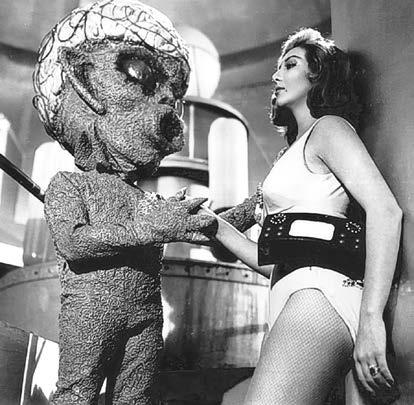
RETROFAN May 2023 42
ABSA.
V OGER ’ S VAULT OF VINTAGE VARIETIES
Those Were the Days…
of All in the Family Collectibles
BY RICHARD KOLKMAN
It’s January 12, 1971: A brief text warning appears on the TV screen, then that familiar song begins: “Boy, the way Glenn Miller played…”
With that came a huge seismic shift in American television and culture. The Mary Tyler Moore Show spearheaded this sea change in 1970, but All in the Family (AITF ) defined it. In the early Seventies, America was changing fast (as always)… and Archie Bunker and family became odd bedfellow pioneers on our TV landscape.
All in the Family wove an innovative seriocomic TV series from love, politics, civil rights, patriotism, war, and family. CBS-TV and series creators Bud Yorkin and Norman Lear, while tweaking the intolerant, asked the burning question: Can bigotry be funny? Popular consumerism’s “Americanism” produces a lot of stuff for the bucks. You won’t find any AITF model kits, trading cards, or lunch boxes here—but in celebration of Norman Lear recently turning 100 (on July 27, 2022), let’s dig out the junk! [Editor’s note: If you came in late, RetroFan #22 featured a Norman Lear interview; you can still snag a copy at twomorrows.com!]
AUDIO RECORDINGS
Before videotapes—and before DVDs and streaming— All in the Family was immortalized on vinyl records. So… sit back and enjoy an evening of loud, intolerant diatribes.

During AITF ’s first flush of success in 1971, Atlantic Records released All in the Family: The First Album (SD 7210). The LP sold well and charted in the Top Ten. Official products like this album are always marked copyright “Tandem Productions, Inc.” (or “TPI”).
The album begins with the memorable theme song “Those Were the Days,” written by Lee Adams and Charles Strouse, a longer version than what started each episode of the CBS-TV series. Presented here are the lyrics to the second and third verses to the theme:
People seemed to be content, Fifty dollars paid the rent, Freaks were in a circus tent. Those were the days.
Take a little Sunday spin, Go to watch the Dodgers win, Have yourself a dandy day that cost you under a fin* Hair was short and skirts were long, Kate Smith really sold a song, I don’t know just what went wrong, Those were the days!
© New Tandem Music Company.
[ *Editor’s note: A “fin” is five bucks.]
After the opening, The First Album features notable excerpts from the show, insanities such as “Sweetie-Pie Roger,” “A Station
Wagon Full of Nuns,” “God is Black,” and “Bacon Souffle and Women’s Lib.” The album enabled classic bits to live on, after disappearing from the airwaves after summer reruns.
The promotion of the earliest AITF products often included actor Mike Evans (Lionel Jefferson) and show creators Bud Yorkin and Norman Lear. Surprisingly, for such a politically divisive show, AITF products always presented a pleasant Bunker family group portrait. One exception is the back cover of this album: Archie and Mike Stivic square off in profile. One strange thing about the biography and lyric insert that was included with the album is the picture on the front. Archie is wearing a white suit with black shirt and a white tie, looking every bit like a Mafia don. (This was before the movie The Godfather was released.) This outfit was uncharacteristic of Archie. He never appeared like this on the show. The First Album was also issued on 8-Track tape and cassette.
“Those Were the Days,” as sung by Archie and Edith, also appeared on an Atlantic 45 RPM single (45-2847), with a picture sleeve matching the First Album cover. This 1971 single features two versions of the theme song, one on each side. A mono/stereo promo also exists.
Buoyed by the success of the first album, Atlantic released All in the Family: The Second (2nd) Album in 1972 (SD 7232). More show excerpts are featured here. “Sammy Davis, Jr.’s Visit,” “Archie and Maude,” “Change of Life,” and “Archie in Jail” help fill out this LP of comedy classics.
RETROFAN May 2023 48
RETRO COLLECTIBLES
(ABOVE) Original cover painting by Norman Mingo for 1973’s MAD Special #11, which included MAD ’s All in the Family take-off “Gall in the Family Fare” on a flexi-disc record. MAD TM & © EC Publications, Inc. Courtesy of Heritage.
(TOP
A Carroll O’Connor (Archie Bunker) album titled Remembering You (A&M SP 4340) also appeared in 1972. Mr. O’Connor croons 12 standards. In addition to the title track (written by Roger Kelleway, with lyrics by Carroll O’Connor—which wordlessly ended AITF weekly on TV), there also appeared: “Just a Memory,” “Last Night When We Were Young,” and “So Rare.” This album was also issued on 8-Track tape (AM8TC0340). A promotional EP was culled from the album, and was also released in 1972 in a picture sleeve by A&M Records (EP-7): “Can We Talk It Over”/“Sweet and Lonely”; “Last Night When We Were Young”/“Remembering You.”

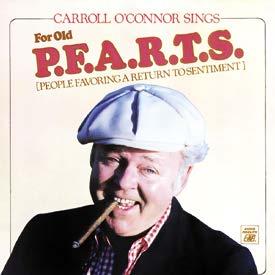

Rounding out 1972, Carroll O’Connor appeared with Cloris Leachman on the TV soundtrack of Of Thee I Sing (Columbia S31763). Jean Stapleton (Edith Bunker), a Broadway veteran (Damn Yankees, Bells Are Ringing), appeared on Barbra Streisand’s 1972 Broadway cast soundtrack album Funny Girl (Capitol STAO 2059). Then there’s the bizarre parody flexi-disc “Gall in the Family Fare” (EC/Evatone B3277327) included as a bonus in EC Publications’ MAD Special #11 (1973). Recorded in New York City and pressed in Clearwater, Florida, this aural re-enactment is from the story’s original appearance in MAD #147 (Dec. 1971).

In 1973, RCA Records released Side by Side: An Evening of Songs and Fun with the Bunkers (RCA APL1-0102). The album promises “solos and duets, song parodies, and a few well-placed wisecracks.” Listening to the entire album is an exercise in endurance. Among the old chestnuts like “You’re the Cream in My Coffee” and “I Remember It Well,” the latter song features some spoken misremembering: Edith claims she and Archie first met in 1942 at the “Astor Hotel under the clock.” Archie claims they met at “Niederman’s Drugstore.” In the series, Maude Findlay sides with Archie’s version. Maude describes how Archie stuck straws up his nose to impress them, as described by Maude with disgust. More contemporary songs were also covered: “Oh, Babe, What Would You Say?” (Norman “Hurricane” Smith’s #3 hit, 1972; formerly, from 1962–1966, Smith was a Beatles recording engineer). The Bunkers even sing the Beatles’ “When I’m 64.” (This song is ironic, since in the series Edith dies at age 53 in 1980, between seasons of the continuation series Archie Bunker’s Place. But thankfully, Jean Stapleton lived to age 90 and died in 2013. Carroll O’Connor passed away in April 2001.)

Later albums get a little murky; in 1976, Audio Fidelity (AFSD 6276) released Carroll O’Connor Sings for Old P.F.A.R.T.S. (People Favoring A Return To Sentiment)
Translation: More old standards. Mr. O’Connor also released one later (undated) album: Carnival of Animals (Location Recording Service LRS-RT-6280).
We also must note the Nineties recording career of Danielle Briesbois (from 1978–1984, Archie’s niece Stephanie Mills) with her disheveled punk persona intact. Another unusual AITF-related musical note: Barry Gordon (Gary Rubinowitz in Archie Bunker’s Place) was a child singing star at age seven: “Nuttin’ for Christmas” (MGM 12092) charted at #6 in 1955. Barry played “Chopper” on Leave It to Beaver —remember him? As for Archie’s rock ’n’ roll tastes? It was revealed on the show that Archie had once mooned the Rolling Stones when they appeared on his TV.
Publicity photos from All in the Family signed by the show’s stars remain popular collectors’ items. All in the Family © CBS. Courtesy of Heritage.

The Internet, of course, has revealed fake records. “Youse Can All Go Eat S***” by Archie (“Atlantic SD 72102”) is a fake album, purportedly sanctioned by Norman Lear. It wasn’t
SCRIPTS
Original All in the Family scripts are a special kind of collectible. They’re out there… and better left to the experts. Anything official will be marked with “Tandem Productions, Inc.”
PHOTOS
Every actor on AITF handed out personalized photos… or at least their agent did. Carroll O’Connor, Jean Stapleton, Rob Reiner, and Sally Struthers all knew how to handle this branch of fame.
RETROFAN May 2023 49
LEFT AND RIGHT) Front and back covers to Atlantic Records’ 1971 LP, All in the Family: The First Album. (RIGHT) The follow-up, 1972’s Second Album. All in the Family © CBS.
You’re a hardcore All in the Family fan if you own these records!
The Amazing Cheryl Miller

At ten years old, I wanted to be Paula Tracy of Daktari. I could not imagine a more exciting life than protecting and caring for wild animals in Africa. The idea of being in the great outdoors, driving a jeep, riding a lion, and cuddling baby animals was intoxicating. Her story was not typical “girl” stuff—Paula, played by actress Cheryl Miller, spoke to the animal and nature-loving tomboy in me.
Every Tuesday from 7:30 p.m.–8:30 p.m., I was glued to the TV, watching my heroine in her latest adventure. What would Paula, Dr. Tracy, Jack, and Mike encounter along the way in their efforts to protect the animals—poachers, fires, floods, rhinos, leopards, alligators? All, and then some! But it wasn’t all drama. The hijinks of exotic beasts at the compound, especially Judy the Chimp and Clarence, the Cross-Eyed Lion, provided loads of fun. They were the real stars of the show.
Through Paula’s escapades on Daktari, I saw a different kind of girl, physically strong with skills, guts, and resourcefulness. Thanks to Miller’s characterization of Paula, I had a role model. I soon became an enormous lifelong fan of Cheryl Miller and Daktar i.
With the help of a weekly allowance and a bicycle, I collected every picture and article I could find on Cheryl and Daktari. I frequently rode my bike to stores in the area, where I spent long and happy hours poring over movie magazines. I ordered glossies from Stephen Sally and Jeri of Hollywood; to this day, I still get a thrill from receiving large brown envelopes in the mail. I covered my bedroom wall with my treasures. That Christmas, my parents gave me a scrapbook hoping I would clean off that wall, which I did. I cherished that scrapbook and kept it throughout my life.
SUSAN BAILEY WITH KEN LYNCH
CREATING A FOREVER SCRAPBOOK FOR DAKTARI
I am now in my sixties, and my “Wameru” consists of three house cats I adore. I didn’t become Paula, choosing instead to write, but I still love the outdoors. And I remain a Daktari fan. In 2013, I lost my beloved scrapbook. Heartbroken, I turned to the Internet to rebuild my collection. I started a website, Daktari TV Show (https://daktaritvshow.wordpress.com/ ), thinking others might appreciate such a collection. Quickly I connected with many diehard fans worldwide, including Ken Lynch from Australia, Patrick Sansano from France, and Walter Steeman from the Netherlands. Their expertise and tireless efforts to compile an episode guide and find long-lost photos, videos, and other information have built Daktari TV Show into a popular website with tens of thousands of views each year. I have more pictures now than I can count! All because I had lost my scrapbook (which I finally found two years ago, to my great delight).
RECOLLECTIONS OF DAKTARI
Lynch writes, “Daktari first aired in Australia in late 1966 or early 1967 when I was 12. I loved action-adventure stories and the African landscape at the time, so it was perfect for me. The developing relationship between the Jack and Paula characters was also an added attraction, probably normal interest for a boy about to become a teenager.”
Steeman first watched the show on Dutch and German TV when he was four. “I remember most Clarence and his crossed eyes and the funny chimp, Judy,” he said. He admitted to being scared when characters faced danger, such as being
RETROFAN May 2023 53 RETRO TELEVISION
‘She rides lions and pushes tigers around and isn’t even afraid of snakes!’
BY
Actress Cheryl Miller in a publicity still from the 1965 pre-Daktari movie release, Clarence the Cross-Eyed Lion. © 1965 MGM. Courtesy of Susan Bailey.
trapped in a pit with a wild animal. In the Eighties and Nineties, Daktari was rebroadcast, piquing Steeman’s interest. He began searching for information about the series. “I found more and more on the internet about Daktari and even episodes to watch again, and when the series was on DVD, I bought all four seasons,” he said. “At that time, I discovered Susan’s Daktari TV Show website and helped her to find information about the series and actors.”
He was most fascinated by Cheryl Miller. “Cheryl Miller is interesting because she is a beautiful woman with many skills besides acting, like singing and playing music, flying airplanes, horseback riding, etc. It is unbelievable where she found the time to do all this!”
Steeman also grew to appreciate Daktari ’s message. “Fifty-six years ago, this show gently reminded fans to be aware of nature, wild animals, and the Earth’s resources,” he said. “Daktari was a unique TV series with a message that still stands the test of time.”
FAVORITE MOMENTS
My favorite episodes were Season Two’s “Terror in the Bush,” “Countdown for Paula,” and “The Return of Clarence,” and Season One’s two-part episode, “The Return of the Killers.” The trailer for “The Return of the Killers” initially attracted me to Daktari, and I became hooked. Watching these episodes as a child, I was thrilled at the amount of screen time given to Paula and all the adventures she experienced.
Some 50 years later, as an adult, I noticed undertones to these episodes that made them even more enjoyable. The tender and close relationship between Dr. Tracy and his daughter shown in “Terror in the Bush” and “Countdown for Paula” was touching. He had great faith in her abilities, especially in “The Return of the Killers,” when she had to remove a bullet from a convict, taking instructions from her father on the walkie-talkie.
VALUABLE MESSAGES
But as aforementioned, Cheryl’s Paula was an outstanding role model for young girls. In “Terror in the Bush,” Paula had to rely on her resourcefulness, creative problem-solving, and raw courage to save her father after their jeep had overturned. The scene where she wrestles with the alligator before bringing her father across the river to safety still has me on the edge of my seat whenever I watch it.
Daktari was groundbreaking in other ways. Steeman mentioned that the show presented a meaningful message about protecting the environment by example rather than preaching. Daktari was also the first television series providing many roles for Black actors portraying various characters.
DAKTARI’S BEGINNINGS
What brought about this show that has inspired such passion? Daktari (Swahili for “doctor”) was developed as a result of a film geared towards children. Ivan Tors produced the series following his 1965 MGM film Clarence, the Cross-Eyed Lion, which served as a pilot. It was a family-friendly movie about a veterinary surgeon, Dr. Marsh Tracy (Marshall Thompson), heading up the Wameru Study Center for Animal Behaviour in East Africa with his teenage daughter Paula (Cheryl Miller). Paula had adopted Clarence, a rescued cross-eyed lion, and Judy, a mischievous chimpanzee; they joined her and Dr. Tracy in thwarting poachers from trapping the research gorillas of Julie Harper (Betsy Drake), a love interest for
(TOP) And you thought Mr. Magoo was a bad driver! Poster from producer Ivan Tors’ Clarence, the Cross-Eyed Lion © 1965 MGM. Courtesy of Heritage. (ABOVE) Publicity photo of the Daktari cast. (LEFT TO RIGHT) Cheryl Miller as Paula Tracy, Clarence the Cross-Eyed Lion, Marshall Thompson as Dr. Marsh Tracy, and Yale Summers as Jack Dane. Daktari © Warner Bros. Courtesy of Susan Bailey.
the widowed Dr. Tracy. Popular with young moviegoers, Clarence was an entertaining animal adventure film with plenty of human interaction and comedy.

The film’s success led Thompson and Tors to continue the format in television as Daktari in 1966. The TV series added additional characters, Jack Dane (Yale Summers) and Mika Makula (Hari Rhodes), who assisted Dr. Tracy in protecting, caring for, and studying the native animals. District Officer Hedley (Hedley

RETRO TELEVISION RETROFAN May 2023 54
I Pity The Fool Who Don’t Read This Article
The Golden Life of Mr. T
BY SCOTT SHAW!
When I was a kid, there were scads of talented people out there who had a genuine “bigger-than-life” vibe I admired. I loved the more outrageous members of that crowd in the Fifties and Sixties. Here are a few of my favorites (a few of whom I’ve already written about in previous RetroFan issues): Gonzo journalist Hunter S. Thompson; comics’ carny, Smilin’ Stan Lee; surrealist painter Salvador Dali; prizefighter/ rebel Muhammad Ali; demented improv comedian Jonathan Winters; abstract custom car designer Ed “Big Daddy” Roth; radio deejay Wolfman Jack; cartoon director Bob Clampett; and TV pioneer Ernie Kovacs. They all seemed to me as if they were wearing invisible facades that imperceptibly heightened their unique and eccentric qualities. (Unfortunately, in recent years, it’s also become another branding and marketing tool...)
In 1983, I came across another unique member of the “Bigger Than Life Club.” He was making his first television appearance on NBC’s Late Night with David Letterman, already known by moviegoers as Clubber Lang from Rocky III. Mr. T was an instant star, so iconic that school kids still know who he is 40 years later.

Of course, if you only know Mr. T from The A-Team, you’ll be surprised by his backstory beyond his unique look, attitude, and sense of humor.

SON OF A PREACHERMAN
Mr. T—born Lawrence Tureaud in Chicago’s Southside, Illinois, on May 21, 1952—is a born-again Christian with three children: two
daughters (one of whom is a comedian) and a son from his ex-wife. Muhammad Ali was his “childhood hero.”
His father was a minister, Reverend Nathaniel “Buddy” Tureaud, Sr. Rev. Tureaud had a powerful voice and was an outstanding speaker and an expert on the Bible who could get “the whole church shouting and hollering.” He was proud and wanted to be proud of his kids and raised them with discipline, requiring them to help out around church as choir singers or ushers who collected and counted the donations of cash. “My father did not believe in sparing the rod,” Mr. T said. But the senior Tureaud also had a mellow, fun side—he owned a beat-up, cream-colored, fourdoor 1956 Plymouth, one that young Lawrence loved to ride in.
When he was out of work, Nathaniel became a junkman and would scour Chicago’s white neighborhoods with five of his sons to find castoff toys, bicycles, food, and new clothes for his family, friends, and for bartering. He and his boys would also go into abandoned buildings to collect scrap to sell. “I guess you could say my father had a genius for knowing what the white folks liked to see—they liked to see blacks begging and needing something from them,” Mr. T recalled. Rev. Tureaud was so deft as a charming “smooth talker” that well-to-do people invited him and his kids for dinner, which led to introductions to other privileged whites, who he subtly manipulated to his advantage. “He played his hand like a
RETROFAN May 2023 61
THE ODDBALL WORLD OF SCOTT SHAW!
(ABOVE) Publicity photo of Mr. T, c. 1983. (LEFT) Lawrence Tero’s 1970 high school graduation photo. U.S. Dept. of Defense.
wouldn’t allow him to murder anyone, but understandably, Mr. T couldn’t resist following the mystery. “That whole thing seemed like Mission: Impossible,” HE admitted.
In 1978, Mr. T’s life suddenly changed for the better. “I was called to the Conrad Hilton Hotel and I met the heavyweight champion of the world. I told Leon Spinks, ‘Whether you hire me or not, I am the best bodyguard you will ever find.’ Leon replied, ‘I like T.’ I was instructed to protect him while he was in Chicago.” Spinks was in town for a fight with a white boxer named George Mostardini, and Mr. T was hired to protect Leon while he was there.
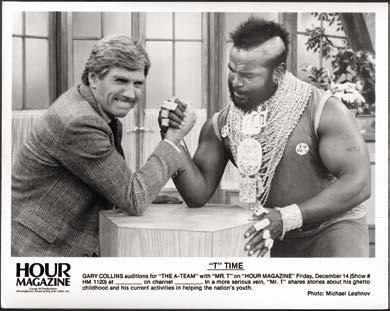
Despite his preparation, there was one aspect that Mr. T hadn’t planned for and couldn’t control: Mostardini’s fan base primarily consisted of aggressive racists who despised Leon Spinks. As Spinks and his bodyguard Mr. T attempted to approach the ring, white supremacists blocked the aisles and yelled racist epithets. “I never ran into so many angry, hostile, and mad white folks in my life,” Mr. T recalled, being puzzled over their motivations. “I couldn’t figure it out… why were they so mad at Leon? What did he do to them? He didn’t try to move into their neighborhood!” Mr. T ascribed their venom to envy; “those white folks didn’t like to see a Black man out of the ghetto making all that money.”
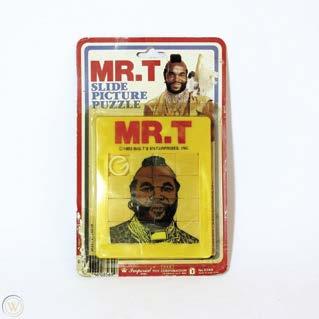
Tensions mounted during the fight as Spinks started pounding Mostardini. Riled white observers tossed beer bottles, cups, shoes, popcorn, and other trash into the ring. Their racist jeering got angrier. An entire section of the amphitheater charged the ring. Things got physical and bloody. Leon Spinks was standing there, watching the chaos. After the police arrived, Spinks’ team had packed and was about to leave in a limousine when the press
showed up. A journalist asked Spinks if he was worried that he might have been hurt during the match. “Leon said, ‘No, because I can deal with anybody in the ring and my man was here.’ The reporter asked, ‘Who is your man?’ and Leon put his arm around me and said, ‘Right here—Mr. T.’”
With his job now full-time, Mr. T was enjoying a posh and exciting lifestyle with one of his heroes. But when you get to know your heroes, you’re sometimes disappointed.

Leon Spinks was a nice enough person, Mr. T. believed, but he was riddled with flaws that endangered his marriage, his career, his health, and his life. Meanwhile, Mr. T was enjoying the bonuses and perks that come with working for the heavyweight champion of the world. But there were ethical issues with which he wasn’t comfortable, like lying for the champ or searching for him when he’s disappeared with people of dubious intent or intimidating him to do his training.
On September 15, 1978, at New Orleans’ Superdome, everything changed. An out-of-condition Spinks was handed his head in a rematch with Muhammad Ali. Within six months, he was running low on cash and fending off multiple lawsuits. “I couldn’t take it anymore,” Mr. T reflected. “I had to start my own career. I just didn’t have a bright future with Leon any more, so I had to let him go.”
TROUBLE WITH A CAPITAL ‘T’
Mr. T was an established bodyguard, a profitable businessman, and a realtor. He was getting respect. Unfortunately, his successes drew unwelcome attention.


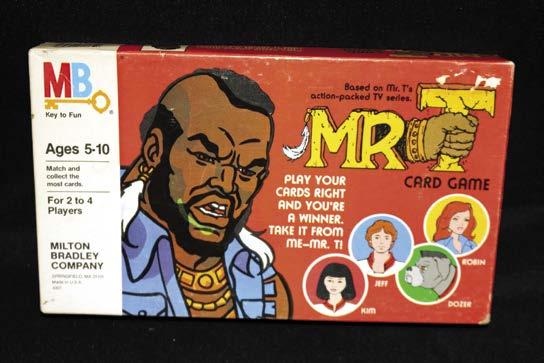

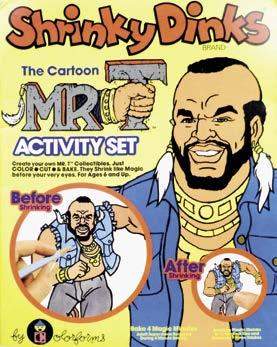
T HE ODDBALL WORLD OF SCOTT SHAW ! RETROFAN May 2023 66
Mr. T, in both live-action and cartoon forms, has been the subject of merchandising since the mid-Eighties.
Mister T cartoon © Ruby-Spears Enterprises, Inc.
While he was serving in the U.S. Army National Guard, due to his arrangement with Leon Spinks, Mr. T let his sergeant know that he wouldn’t be available for scheduled drills and would make up all the ones he missed; he also asked for a leave of absence. Mr. T later learned that the commander had been trying for two years to send him into the Army because he was considered to be AWOL. In early July 1979, there was a warrant out for his arrest. “I have no problem taking orders,” Mr. T remarked, “but don’t give me no dirty deal.”
Meanwhile, two white agents from the Internal Revenue Service began to show up at Mr. T’s apartment, asking lots of questions, apparently suspicious of how a Black man was making so much money. Mr. T hired tax attorneys, but ultimately considered them a waste of funds. “I would supply no more information until I was officially charged with a crime or violation. I was doing nothing illegal. I hadn’t cheated on my tax returns. I was not a drug dealer, nor was I a pimp.”
To make matters worse, Mr. T got in trouble with the Chicago Police Department. While making his way through the crowds at the Air and Water Show at Lake Michigan, he and his friend were told by a policeman that they could walk along a median strip to reach the lake. But minutes later, they were confronted by an overaggressive cop who pulled a gun on him. After a physical encounter with a dozen more policemen, Mr. T was arrested for carrying a firearm and spent six hours in jail. “I was charged with unlawful use of a weapon and they didn’t even find a weapon on me. But the cop who pulled out his weapon, aimed it at me, and cocked the trigger, was not charged.”
While Mr. T was battling in courtrooms to beat the charges the police had against him, the IRS tapped his phone, bank account, and other income sources. Two
THE LAKE FOREST CHAINSAW MASSACRE
Chicagoans know quite well the bizarre story of “The Lake Forest Chainsaw Massacre,” because every time a tree is threatened in the area, Mr. T’s name is invoked.
In 1986, Mr. T bought the sprawling English Tudor es tate Lake Forest for $1.7 million and immediately added a few personal touches to the historic property. A year later, he chopped down over one hundred of the trees on his property. “He’s smiling and laughing about all this,” said one horrified neighbor. “He thinks it’s a joke.” Arborists were stunned.
Mr. T mania was in full swing when our main man dominated the poster for the 1983 ensemble comedy, D.C. © Universal Pictures. Courtesy of Heritage.

RETROFAN #26
The saga of Saturday morning’s Super Friends, Part One! Plus: A history of MR. T, TV’s AVENGERS (Steed and Mrs. Peel), Daktari’s CHERYL MILLER, Mexican movie monsters, John and Yoko’s nation of Nutopia, ELIZABETH SHEPHERD (the actress who almost played Emma Peel), and more! With ANDY MANGELS, WILL MURRAY, SCOTT SAAVEDRA, SCOTT SHAW, MARK VOGER, & MICHAEL EURY (84-page FULL-COLOR magazine) $10.95 (Digital Edition) $4.99

National Guard MPs threatened him. Mr. T worked the police’s illegal moves against them, outlasted the IRS snoops, and found an ally in a National Guard commander who used his clout to revert Mr. T into a civilian.
‘AMERICA’S TOUGHEST BOUNCER’
Mr. T never fully explained why he fired up a chainsaw and, alongside hired workmen, sawed down the oaks, elms, and maples that populated his seven-acre estate. According to a Chicago Tribune report, he left the estate looking as if it had been “ravaged by an army of beavers.”
https://twomorrows.com/index.php?main_page=product_info&cPath=98_152&products_id=1704
In the late Seventies, Dingbats Disco was one of Chicago’s hottest nightclubs. “Dingbats was a rough and rowdy place simply because it was predominantly Black,” Mr. T said. “If you came down to Dingbats and didn’t know how to dance, I’ll bet you learned before you left.”
In 1988, prompted largely by the public outrage over Mr. T’s behavior, Lake Forest enacted a tree preservation ordinance to prevent developers and homeowners from chopping down trees.
Mr. T was its doorman who checked I.D.s and made sure that everyone had a good time. That meant patrolling the restrooms for drugs, mingling with the guests, dancing with the ladies, and handling problems quickly, professionally, and quietly. Being the club’s top bouncer, “I was challenged a lot. It’s like being the fastest gun in the West—some people would stay out of your way, while
RETROFAN May 2023 67
T HE ODDBALL WORLD OF SCOTT SHAW !
IF YOU ENJOYED THIS PREVIEW, CLICK THE LINK TO ORDER THIS ISSUE IN PRINT OR DIGITAL FORMAT!




























 BY WILL MURRAY
BY WILL MURRAY











 BY MARK VOGER
BY MARK VOGER

























